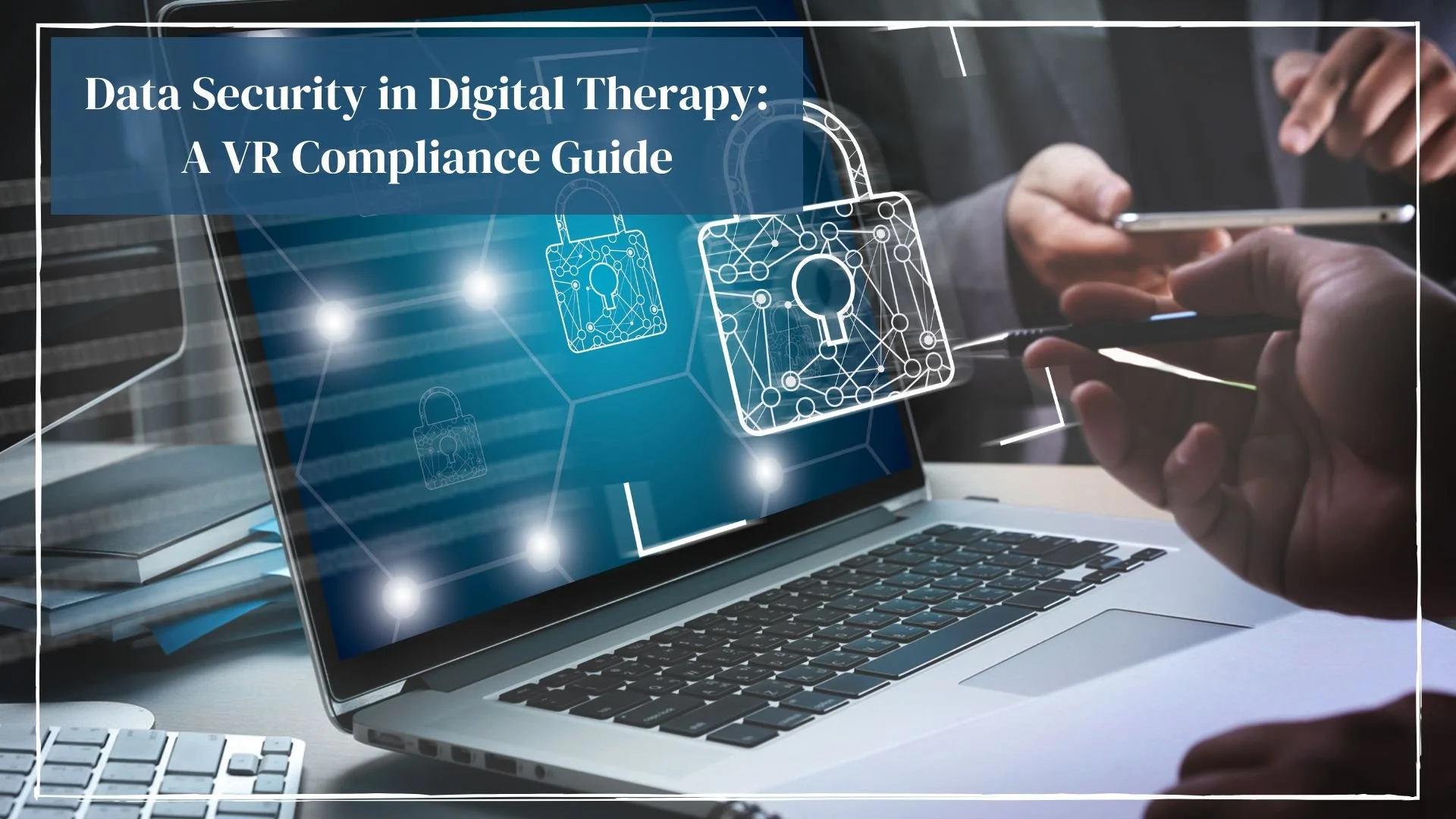Data Security in Digital Therapy: A VR Compliance Guide
Written by: Brianna Hodge
We live in a world where digital experiences are reshaping healthcare. For rehabilitation clinicians, virtual reality (VR) therapy platforms represent one of the most exciting advancements in patient care, bringing gamified movement, cognitive engagement, and real-time feedback to therapy sessions. But with innovation comes responsibility. Behind every motion-tracked squat or attention-focused cognitive drill lies a wealth of sensitive patient data, and protecting that data is just as important as the therapy itself.
If you’re a therapist, administrator, or tech professional working with digital therapy systems, you’re likely asking: Is my patient data safe? Are we HIPAA-compliant? What happens if there’s a data breach?
In this blog, we’re going to explore the critical topic of cybersecurity in digital therapy platforms, especially those using immersive technologies like VR. We’ll break down real-world risks, look at how HIPAA applies in a virtual setting, examine encryption standards, and review how companies like Neuro Rehab VR are stepping up to secure the future of digital care.
Rowan-Cabarrus Community College
Why Cybersecurity in Digital Therapy Matters
Healthcare is one of the most targeted industries for cyberattacks—and rehab clinics and therapy centers are no exception. Patient health information (PHI) includes some of the most sensitive data available: diagnoses, physical and cognitive impairments, medication history, therapist notes, and more. When this information is stored, transferred, or processed through digital therapy systems, it becomes a prime target for hackers.
The average cost of a healthcare data breach in the United States is over $5 million. More importantly, the cost to patient trust and organizational reputation can be immeasurable. In the world of virtual rehabilitation, where the line between physical care and digital infrastructure is increasingly blurred, cybersecurity is not just an IT issue, it’s a patient care issue.
The Risks of Immersive Technology: An IT and Compliance Lens
Virtual reality brings a new dimension to therapy, and with it, a new layer of risk. Traditional electronic health records (EHR) systems typically involve a single point of access through a secure network. VR therapy, by contrast, introduces:
Multiple hardware endpoints (e.g., VR headsets, tablets, sensors)
Wi-Fi or Bluetooth communication protocols
Cloud-based data transfers between clinics and vendors
Real-time streaming of patient performance data
AI integrations that generate and store clinical documentation
Each of these components can create vulnerabilities if not properly secured.
Research:
As highlighted in Transformative Frontiers: A Comprehensive Review of Emerging Technologies in Modern Healthcare, the lack of standardized integration with conventional IT frameworks can expose immersive medical devices to unique risks, such as weak authentication protocols, unsecured wireless connections, and third-party software vulnerabilities.
The study emphasizes the urgent need for robust cybersecurity frameworks tailored specifically for medical devices that use immersive interfaces—calling for device-level encryption, secure firmware updates, and formalized security audits as part of regulatory compliance. (Yadav)
As the therapeutic benefits of immersive technologies grow, so must the security strategies that support them.
HIPAA, FDA, and Digital Therapy: The Full Regulatory Picture
If you’re a U.S.-based therapy provider, the Health Insurance Portability and Accountability Act (HIPAA) is your gold standard for patient data protection. But how does HIPAA apply in a VR-based therapy setting?
Let’s simplify it. HIPAA covers:
Privacy Rule: Ensures patients' rights to privacy over their health information
Security Rule: Requires covered entities to implement physical, administrative, and technical safeguards
Breach Notification Rule: Mandates reporting of any breaches affecting more than 500 patients
In VR rehab platforms, HIPAA compliance should be baked into the system architecture. This includes:
End-to-end encryption for any data transmitted during therapy sessions
Access controls for clinicians, administrators, and system users
Audit trails that track who accessed patient data and when
Secure cloud storage that meets HIPAA requirements for business associates
And yes, even AI-generated SOAP notes fall under HIPAA’s domain. If AI software is generating clinical documentation, it must meet the same security and privacy standards as any EHR platform.
FDA in Digital Therapy:
While HIPAA ensures that patient data is handled responsibly, it’s only one piece of the regulatory puzzle. If you’re working with a VR therapy platform that is considered a medical device or contributes to medical decision-making, the U.S. Food and Drug Administration (FDA) also plays a role in oversight.
The FDA’s role is to ensure that medical devices are safe, effective, and reliable, and yes, that includes digital health software and immersive rehabilitation platforms. Depending on how the VR solution is used, it may fall under:
Class I or II medical device classification
Software as a Medical Device (SaMD) designation
Enforcement discretion when used for general wellness but not diagnostic functions
This matters because clinicians and administrators need to be confident not only in how secure a system is, but in how rigorously it has been evaluated for clinical performance and safety.
Neuro Rehab VR: HIPAA-Compliant and FDA-Registered
At Neuro Rehab VR, cybersecurity isn’t an afterthought, it’s foundational. From the start, our platform has been developed to meet the highest standards of patient safety, data privacy, and clinical compliance.
✅ HIPAA Compliance
We maintain full HIPAA compliance across our systems, including both software and hardware configurations. This means:
All data is encrypted in transit and at rest
Access is role-based and requires multi-factor authentication
Logs and audit trails are maintained for system activity
Business associate agreements (BAAs) are in place with any third-party partners
🧠 FDA Registration
Neuro Rehab VR’s immersive rehabilitation platform is also FDA-registered as a Class II medical device, meaning it adheres to federal standards for safety and effectiveness under 21 CFR Part 880. This designation confirms our system is built for clinical use and governed by strict quality controls, documentation practices, and manufacturing standards.
💾 Secure AI SOAP Notes
One of our standout features is an AI tool that automates SOAP notes for therapists. While this improves workflow efficiency, it also introduces a compliance obligation. That’s why our AI note generation process is secured with encrypted APIs and integrated user authentication.
All notes are stored in secure HIPAA-compliant environments and only accessible by authorized clinicians. The system logs each action, so clinics can maintain a complete record of documentation workflows.
🔐 Cloud Infrastructure
Our cloud infrastructure uses enterprise-grade hosting with AES-256 encryption and TLS 1.2 security for all communications. We conduct regular security assessments and are constantly updating based on evolving best practices.
The Role of Encrypted Data Streams in VR Therapy
Let’s talk tech for a second.
Encryption is the backbone of data protection in digital therapy. It ensures that even if someone intercepts the data stream between a VR headset and a clinic’s server, the information will be unreadable without the correct decryption key.
There are two main types of encryption in VR therapy platforms:
Data-at-rest encryption: Protects stored information, such as session results, progress notes, or videos.
Data-in-transit encryption: Secures data as it travels across networks, especially crucial for telehealth or cloud-based VR platforms.
HIPAA does not mandate specific encryption algorithms but does require “addressable implementation” of encryption best practices. That means covered entities must either use robust encryption or document why it's not feasible, and what alternatives are being used.
Best-in-class systems use AES-256 (Advanced Encryption Standard with 256-bit keys), which is nearly impossible to break with brute force attacks. Combined with SSL/TLS protocols for secure network communication, these technologies help ensure that your patient data isn’t just functional, it’s fortified.
Case Study: Breach in a Connected Therapy Device
According to the HIPAA Journal’s latest healthcare data breach statistics, the number of individuals affected by security incidents remains alarmingly high, with tens of millions of patient records compromised each year. (Alder)
In many cases, a single breach can expose the personal health information (PHI) of hundreds of thousands, if not millions, of people. The most common causes of these breaches are hacking and IT incidents, which now account for the majority of reported cases, followed by unauthorized access or disclosure, loss or theft of devices, and improper disposal of records.
The trend highlights that while accidental mishandling still occurs, malicious cyberattacks are the primary driver behind large-scale PHI exposure, underscoring the urgent need for advanced security measures, regular risk assessments, and strong access controls in all healthcare technologies, including VR-based therapy systems.
Staff Training and Cyber Hygiene: The Human Factor
Even the best encryption in the world won’t protect against human error. Most breaches involve the “human element”, such as, phishing, weak passwords, or mishandled access credentials.
That’s why digital therapy providers must train their teams to practice good “cyber hygiene”:
Don’t share login credentials
Use multi-factor authentication
Regularly update and patch all devices
Report suspicious emails or activity immediately
Lock screens when leaving devices unattended
VR therapy often involves shared hardware like headsets and tablets. Proper protocols for cleaning, logging out, and password management are essential.
What to Look for in a Secure Digital Therapy Vendor
Choosing a digital therapy solution means choosing a security partner. Here’s a checklist you can use to vet vendors:
HIPAA Compliance: Ensures legal protection and privacy
FDA Registration: Confirms medical safety and quality standards
Data Encryption (AES-256): Secures both stored and transmitted information
Role-Based Access Control: Prevents unauthorized access to patient records
Multi-Factor Authentication: Adds a second layer of login security
Secure Cloud Hosting: Reduces risk of breaches via robust infrastructure
AI Documentation Logging: Tracks every AI action for transparency
Audit Trails: Creates accountability in data access and usage
BAA Availability: Shows vendor responsibility under HIPAA
Security Audit Reports: Confirms ongoing compliance and testing
Don’t be afraid to ask vendors for documentation or a call with their compliance team. If they can’t give you straight answers, that’s your answer.
Real-World Implementation: The VA System
The U.S. Department of Veterans Affairs (VA) has one of the most rigorous security protocols in healthcare. Select VA Medical Centers have began implementing VR therapy programs, including partnerships with companies like Neuro Rehab VR. These partnerships required comprehensive audits, system reviews, and security clearances before deployment.
The result? VR sessions that are immersive for veterans and secure for administrators. The experience offers a compelling example of how digital therapy and strict compliance can coexist when systems are designed with intention.
The Future of Cybersecurity in Immersive Rehab
As virtual therapy continues to evolve, so will the threats. Deepfake technology, AI hallucinations, and biometric tracking are just a few of the concerns on the horizon. But there’s also reason to be hopeful.
Emerging technologies like zero-trust architectures, blockchain-based audit trails, and post-quantum encryption algorithms are paving the way for even more secure rehab platforms. Likewise, AI-driven anomaly detection may soon help flag suspicious activity before it becomes a breach.
Digital therapy doesn’t have to compromise privacy for performance. With proactive planning and strong vendor partnerships, clinicians can ensure their patients are protected, mentally, physically, and digitally.
Conclusion: Therapy You Can Trust
You wouldn’t hand over patient care to a device that didn’t work. So why hand over their data to a system that isn’t secure?
As clinicians, administrators, and healthcare innovators, we have a responsibility to ensure the technology we use meets the highest standards, not just for outcomes, but for safety. That includes cybersecurity.
By choosing HIPAA-compliant platforms, enforcing strong encryption, vetting for FDA registration, and educating staff, we can build a future of therapy that’s not only immersive and effective, but also safe, secure, and trusted.
Neuro Rehab VR is proud to lead by example in this space, because we believe healing and privacy should always go hand in hand.
-
Alder, Steve. “Healthcare Data Breach Statistics.” The HIPAA Journal, 26 May 2025, www.hipaajournal.com/healthcare-data-breach-statistics/.
Yadav, Sankalp. “Transformative Frontiers: A Comprehensive Review of Emerging Technologies in Modern Healthcare.” Cureus, vol. 16, no. 3, 20 Mar. 2024, www.cureus.com/articles/230344-transformative-frontiers-a-comprehensive-review-of-emerging-technologies-in-modern-healthcare.pdf, https://doi.org/10.7759/cureus.56538.





